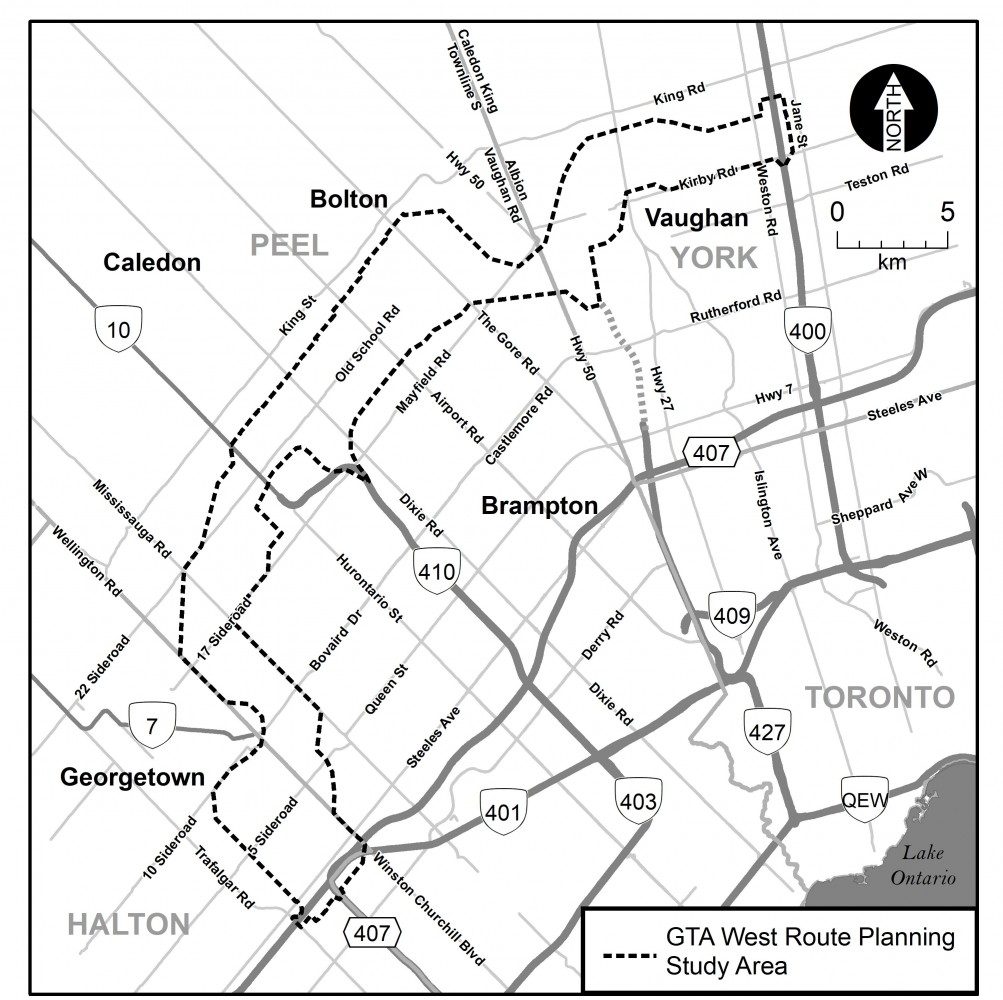
GTA-West Highway was killed for its bad planning; its revival by Doug Ford could be killed by COVID-19
Mary Shelley’s classic Frankenstein tells the tale of a young scientist and his quest to bring life to a series of body parts he stitched together. It follows Doctor Victor Frankenstein, who uses lightning to animate flesh and brings to life a monster beyond his worst nightmares.
It’s a story that has resonated around the world since its publication in 1823. It has spawned everything from sophisticated critical analysis to themed bars and monster films.
It’s the ultimate cautionary tale; a story that explores man versus nature, our own mortality and the danger of playing God.
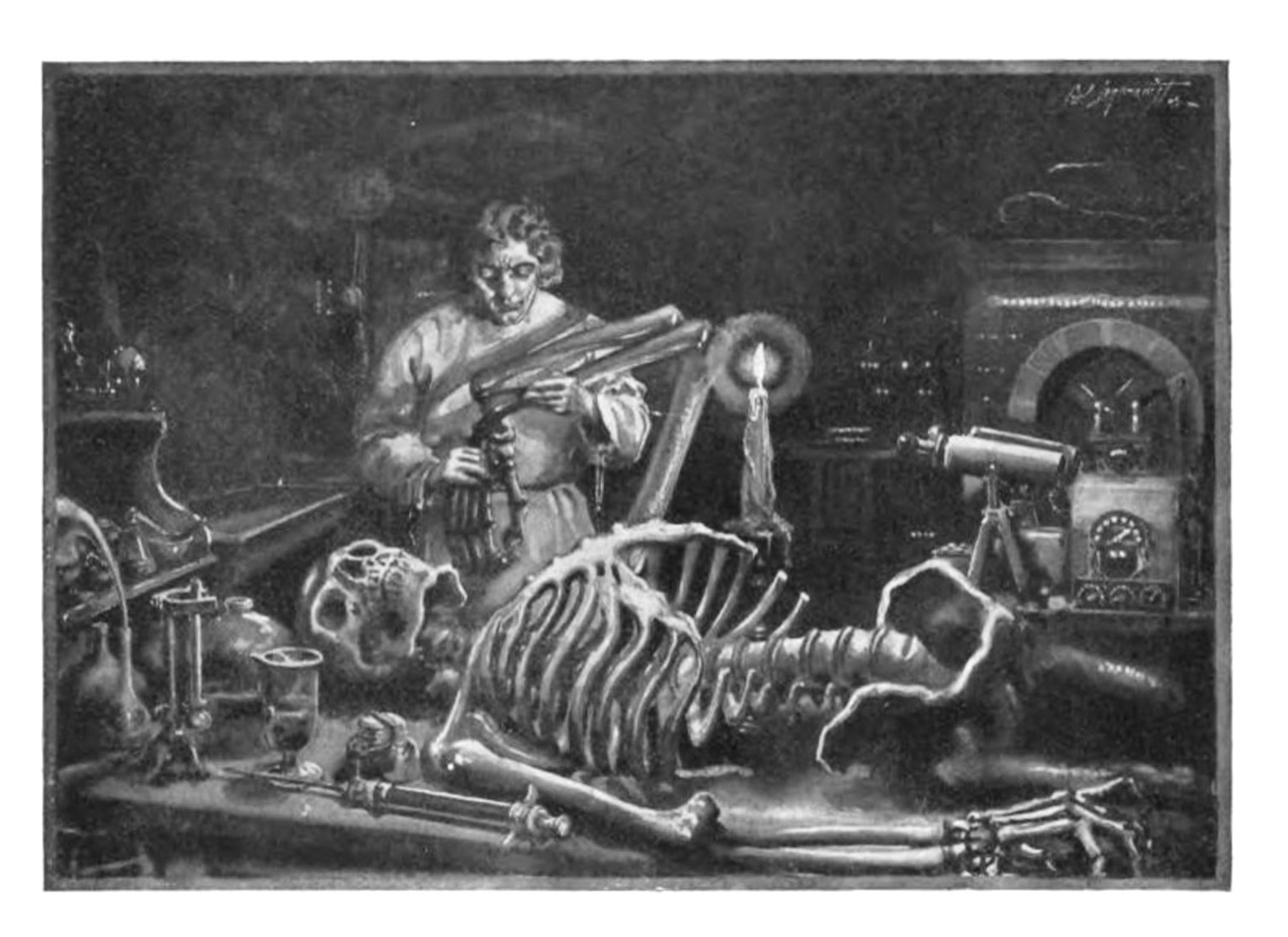
The GTA-West Highway has been stitched together from studies and plans completed over many years, and much like Dr. Frankenstein's monster, the end result could be disastrous.
In 2019, on the heels of his landslide victory in the provincial election, Doug Ford seemed to take inspiration from the infamous Doctor Frankenstein. Buoyed by a thumping victory and with promises for friendly developers to keep, he laid the parts of an old policy on a table. Stitching old plans together and waiting for lighting to strike, a creation was reborn.
After a year and half sitting cold, the GTA-West Highway was reanimated.
The project had been suspended by the Liberals in 2015 in the face of growing concerns about the environment and suburban sprawl, before it was eventually shelved in 2018. It had been originally pushed by developers and politicians 15 years ago, as builders wanted to capitalize on land they had been accumulating for years and proponents of outdated transportation design claimed it would ease congestion on the 401 Highway.
After the idea was killed the administration did not dispose of the body, or its revived Environmental Assessment process, and Ford was allowed to rekindle the project, picking up exactly where it left off.
The previously stated reasons for caging and eventually killing the monster had already raised questions about why anyone would want to bring it back to life.
But now, with the COVID-19 pandemic clearly shifting the way corporations around the world think about work and the need for commuting into an office, the idea of reviving the GTA West Highway seems absurd.
Shopify, the Ottawa-based global ecommerce giant is just one of hundreds of companies in Ontario that are planning to dramatically cut down on commuting into an office or other place of work.
"Office centricity is over," Tobi Lutke, the company’s CEO, tweeted recently. "As of today, Shopify is a digital by default company.”
Shopify, like thousands of other companies, will redefine its physical space strategy for the new reality, which isn’t just a response to the virus, it’s about smarter transportation, happier employees, better planning for the environment and more cost-effective thinking around commercial real estate needs. Most employees will work from home, some permanently and some in a rotating design.
"Until recently, work happened in the office. We've always had some people remote, but they used the internet as a bridge to the office. This will reverse now," Lutke tweeted. "The future of the office is to act as an on-ramp to the same digital workplace that you can access from your #WFH (Work From Home) setup."
Global surveys have shown that as many as 70 percent of companies polled intend to shift away from office work in favour of more work from home, and that most who reported no such plans are limited in their physical space models because of the nature of the business, such as manufacturing factories.
IBM released a survey of 25,000 American adults in early May, which showed more than 75 percent would like to continue working from home.
And even survey data that indicates more people will stay away from public transportation, in favour of a personal car, shows this will likely only last until the virus is in check, while long-term attitudes indicate far fewer people are interested in buying a new car or ever owning one.
Another key trend is investment in public transportation. It makes little sense, for example, to have Brampton councillors pushing a possible $1.7 billion tunnelled LRT extension into the downtown, with future transit investment across the city to support the rail link, while simultaneously supporting the GTA West Highway. The province’s entire Big Move transportation plan for southern Ontario is a $50 billion commitment to invest in public transportation while moving away from the construction of infrastructure for single-occupancy cars. And the federal government has made clear that its priority under the $188 billion Invest In Canada Plan for future infrastructure, is public transportation, part of Ottawa’s commitment to reducing greenhouse gasses and decreasing the rise of global temperature.

Office towers usually filled with workers, like these seen in Toronto's financial district, could become much quieter after the COVID-19 pandemic ends. Many companies plan to move away from office work which will decrease the need to expand highway infrastructure.
With generational trends moving away from highway commuting, environmental awareness pushing more young people away from cars and the long-term, perhaps permanent trend, of working from home, the rebirthing of a monster like the GTA West Highway seems destined to either be ditched once again or turn out very bad, just like Frankenstein.
But developers who gobbled up land along the proposed corridor are the ones pushing for the monster and it’s all about the big pay-off they expect. Ford made the promise during the 2018 election, when he told them that, in return for their support, he would open up the Greenbelt for them to build on. The revived GTA West Highway is the vehicle to do so.
The plan was put to rest in February 2018, after an expert panel appointed by the province found it to be in contravention of the government’s own planning objectives, detrimental to the environment and not an effective way to reduce congestion.
The decisive expert report is no longer easily available or linked on the Government of Ontario or Ministry of Transportation websites, but a copy can be accessed using web archives.
(You can read the full document here).
The pitch behind the highway’s original creation was to connect the two fast growing centres of Vaughan and Milton, cutting through Caledon right above Brampton and then down its western edge. Proponents claim the highway would serve the rapidly growing populations along the corridor while alleviating overflowing volumes on the 401, North America’s busiest highway. They also say the new thoroughfare would connect people to their jobs alongside and around various parts of the route.
These claims are refuted in much of the analysis that was done under the previous Liberal government, which led to the project’s demise.
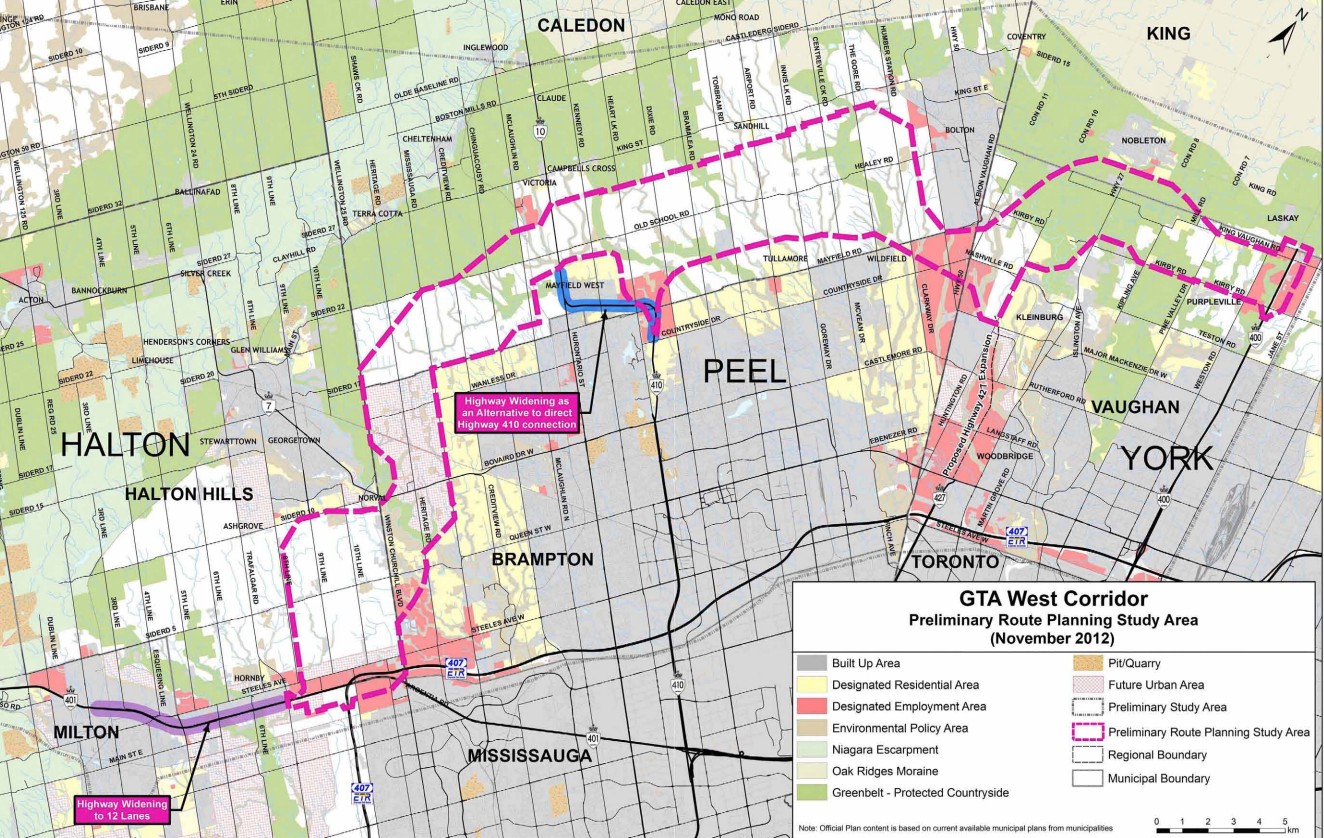
The initial study area for the GTA-West Highway, planned to run from Vaughan to Milton.
Instead of connecting the satellite communities of Milton and Brampton to job centres like Toronto Pearson Airport or downtown Toronto, the GTA-West Highway (the 413 is the number associated with the plan) would connect them to one another. There is very little demand for commuter or other travel between the Milton area and Vaughan, and analysis has raised questions about how much volume would divert away from the 401.
The 407 toll highway is designed for drivers who want to avoid the 401, across the entire GTA, and runs much closer to key destinations such as Pearson Airport, while the proposed GTA West corridor would only run between Milton and Vaughan, well above the 407, and too far north to connect with some of the busiest employment zones in Peel and York regions.
Even assuming the planned corridor has some value, the congestion savings it offers are minimal.
“The GTAW Recommended Actions would deliver approximately one minute of travel time savings per vehicular trip across the Greater Golden Horseshoe,” the panel observed in 2018. But even that one minute will only come if other highway expansions and modifications (many of which are already underway) are realized, while just 30 seconds will be saved as a direct result of the proposed GTA-West Highway.
So, massive disruption to the protected Greenbelt, which the highway would encroach on, and other environmental damage caused by putting more cars on roads, would achieve very little in actual transportation benefits, the panel concluded.
When it considered the issue of congestion and faster journeys, several options proved more effective without the same disruption. The GTA-West’s proposed route will run alongside the Greenbelt, and sprawling development would almost certainly open up parts of the protected area, which is what Ford promised developers during the 2018 election campaign.
The negative impact of such development and the loss of Greenbelt lands could be avoided with simple alternatives.
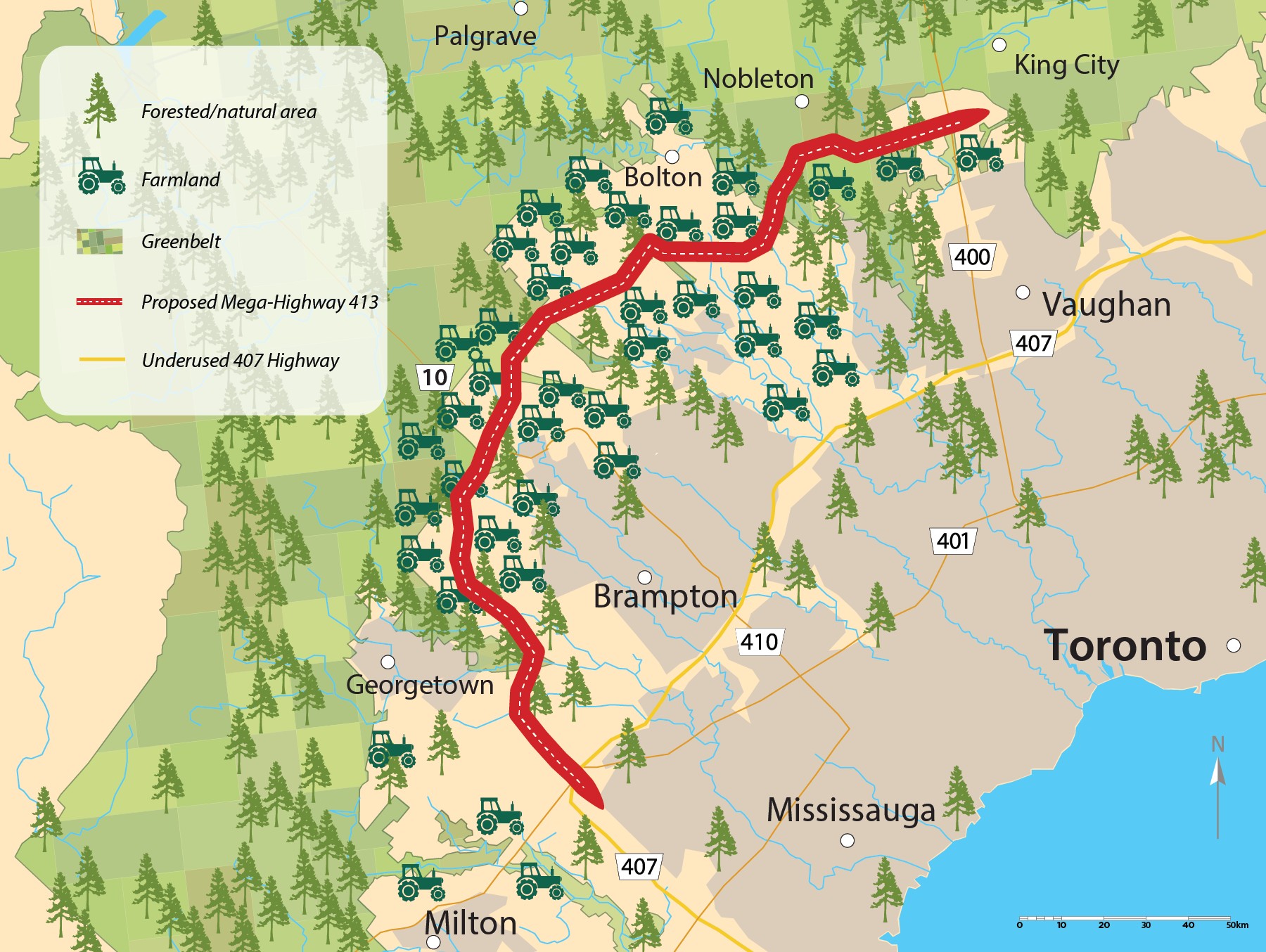
An illustration from Environmental Defence shows how close the planned GTA-West Highway would run to environmentally sensitive lands like the Greenbelt.
Modelling that used more compact land use planning and infill development “resulted in shorter travel times than those delivered by the proposed GTAW highway,” the panel reported, while congestion pricing would be a much more effective way to reduce volumes.
Congestion pricing is the practice of charging drivers to travel in certain lanes, areas or for certain distances to discourage the use of the car. Cities like London (England) employ congestion charges on vehicles entering the city to encourage transit use, while the same philosophy can be applied to roads.
Similar to the carbon tax or duties on cigarettes and alcohol, the scheme is designed to increase cost and deter use by taxing people who continue to create expenses. The impacts of environmental damage range from dramatically higher healthcare costs associated with respiratory illness and other conditions to climate change-related weather events that cost billions of dollars each year. The economic costs of congestion include an estimated annual loss of $15 billion by 2031 across the Greater Toronto and Hamilton Area, as a result of lost productivity, delayed service delivery and other commercial impacts from poor transportation, according to HDR, an environmental engineering firm that was commissioned by provincial public transportation agency Metrolinx to do the research.
The decision to kill the GTA West Highway was partly based on conclusions that it would do almost nothing to reduce congestion, and would eventually create even more traffic chaos.
“The Panel found that congestion pricing scenarios provided travel time savings ranging from approximately equal to more than 10 times greater than those projected from the new GTAW corridor,” the group’s findings state.
Instead of pursuing the GTA-West, the government was advised to develop a single strategy for transit across the Greater Golden Horseshoe.
“The EA did not demonstrate that a new corridor which crosses protected lands (both prime agricultural lands and key natural heritage and hydrologic features) was the only option available to address the study area’s future transportation needs,” the panel added.
The key finding at the heart of the panel’s suggestion to kill the sprawl inducing monstrosity was the fact it contravened provincial guidelines. This happened particularly as Ontario began to adopt more environmentally conscious policies, especially after Canada signed the Paris Agreement in 2016.
“From 2004 to 2006, changes to planning legislation and the introduction of new policy required transportation planning decisions to … conform with the policies of the Growth Plan (2006) and the Greenbelt Plan (2005)”, the panel found.
Referencing numerous studies, the panel pointed to the fact that more highways mean more traffic and eventually more congestion. While a new highway would perhaps have short-term personal benefits through marginally shorter commute times (30 seconds shorter in this case), even a slight time-saving encourages more drivers onto the road and eventually leads to similar or worse congestion. It also remains unclear how many people would actually benefit from a route that connects Milton and Vaughan. If the highway leads to more transportation-based businesses along the corridor, primarily warehouse-based enterprise, Brampton, Caledon and parts of Vaughan would see even more land wasted on low slung, sprawling fulfillment centres, storage spaces and warehouses that create few high-paying jobs and eat up the potential property tax base. Meanwhile, more and more commercial trucks would be constantly running through the municipalities, sharing roads and the new highway with residents living in sprawling subdivisions approved along the corridor.
Basically, it would be a continuation of the terrible, sprawling suburban highway design created since the ‘70s, which has eaten up most of the land throughout the 905.
The development that would take place along the highway would also exacerbate concerns, with most new residents reliant on cars, something the government’s planning policies discourage.
“Additional highways can induce significant suburban expansion,” the panel wrote. “Since compact and complete communities are a policy objective in Ontario’s Growth Plan (2006), understanding the relationship between transportation infrastructure investment, urban growth and suburban sprawl is critically important.”
Even as Ford has reanimated the monster that is the GTA-West Highway, he signed off on policies that purport to push for intensification. The Provincial Policy Statement, for example, that came into effect on May 1 as part of Bill 108, tells cities to build in already built up areas instead of sprawling out.
How the revived GTA-West corridor can work within this context is unclear.
What is clear is that local municipal leaders, greedy for developer dollars and flippant about the future of the environment, are delighted with the decision. In Brampton, councillors endorsed the EA for the project last year at the same June meeting they declared a climate emergency, while councillors at the Region of Peel, including those same ones from Brampton, repeated the same contradiction shortly after.
The project has more tone-deaf advocates to the north.
Speaking to the Toronto Star after the highway was originally scuttled, Caledon Mayor Allan Thompson continued to conflate the new infrastructure with congestion. “Congestion on Caledon roads and gridlock throughout the GTA continues to grow which has a significant impact on our plans for development and overall economic competitiveness,” he said. “The GTA West corridor has already been identified as a necessary piece of growth infrastructure to help alleviate traffic concerns which impacts residents and visitors.”
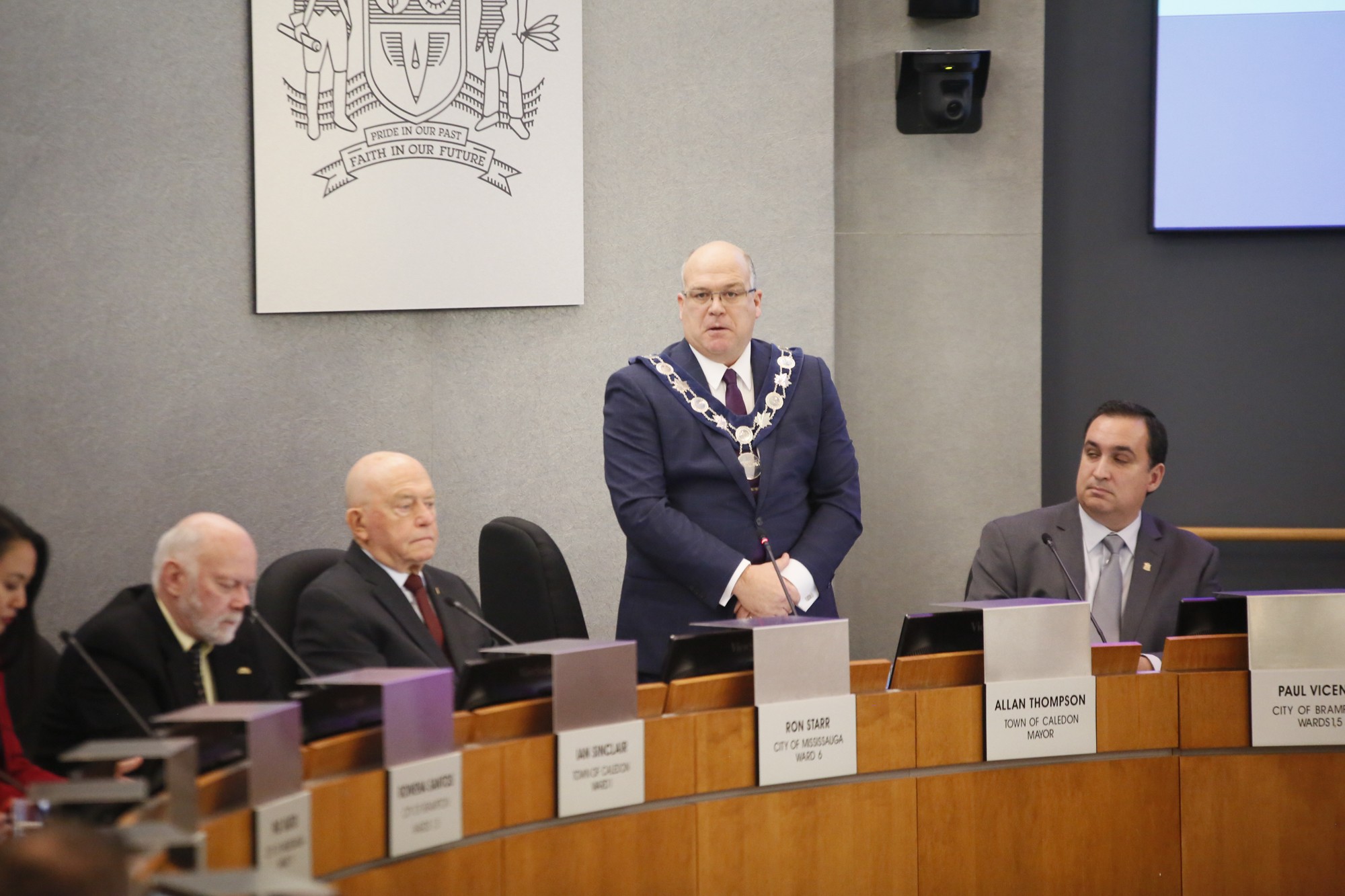
Caledon Mayor Allan Thompson
Thompson will personally benefit from the eventual domino pattern of development along the proposed corridor because of a $9.4 million deal he made to sell family land along the highway corridor to residential subdivision builder Primont Homes.
His claims about congestion and economic competitiveness are refuted by studies of the highway’s impact. What it would do is cut off good planning, in favour of old sprawling models supported along the highway and approvals the province could force in conjunction with its future project. Mississauga and Brampton will end up subsidizing the lion’s share of this bad, sprawling style of planning in Caledon, while much of Brampton’s western edge would see similar types of growth, which does not align with its own 2040 Vision master plan. Mayor Patrick Brown has endorsed both, the GTA-West Highway and the 2040 Vision, which are incompatible. He claims to support smart growth including environmentally conscious planning, while also pushing for the new highway.
Now, with the likelihood of far less commuter demand as more companies move away from office work, there’s even more concern about a highway with little benefit, but plenty of associated harm.
The reasons for its original cancellation should ring true with Brown, Ford and other Progressive Conservatives who have recently said politicians need to listen to experts.
Ford has spent the past few months touting his reliance on researchers and medical professionals in relation to COVID-19; experts said the highway should be stopped. Ford's own planning documents, and the ones now guiding Brampton, talk about public transit, density and infill; the GTA-West corridor will increase sprawl and increase reliance on the car. Ford is the driver’s friend and has talked about reducing congestion; experts say a charge to drive would be ten times more effective than his new highway.
With the EA process picking up almost exactly where it left off, none of the myriad problems raised by the expert panel have been addressed. Instead, Doug Ford and his government have pressed on with a project provincially appointed experts said needs to be stopped.
Mary Shelley’s classic ends with Doctor Frankenstein wishing he could destroy the monster he unwittingly unleashed.
Could the long-term impact of COVID-19 send Ford’s pet project to a similar fate?
Email: [email protected]
Twitter: @isaaccallan
Tel: 647 561 4879
COVID-19 is impacting all Canadians. At a time when vital public information is needed by everyone, The Pointer has taken down our paywall on all stories relating to the pandemic and those of public interest to ensure every resident of Brampton and Mississauga has access to the facts. For those who are able, we encourage you to consider a subscription. This will help us report on important public interest issues the community needs to know about now more than ever. You can register for a 30-day free trial HERE. Thereafter, The Pointer will charge $10 a month and you can cancel any time right on the website. Thank you.
Submit a correction about this story


